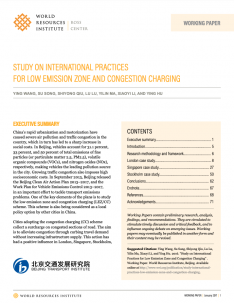Study on International Practices for Low Emission Zone and Congestion Charging

Synopsis
The traffic congestion and its high socioeconomic cost, brought by China’s fast urbanization, has forced the demand for congestion mitigation and emission reduction in the transport sector onto the government’s agenda. Several Chinese cities like Beijing, Shanghai, Hangzhou and Suzhou are considering to mitigate these growing air pollution and traffic congestion issues through Low Emission Zone (LEZ) and Congestion Charging (CC) policies. Based on the policy demands from Beijing Municipal Commission of Transport (BMCT), World Resources Institute (WRI), partnering with Beijing Transportation Institute (BTI), has conducted a comprehensive and thorough research on the successful experience of London, Singapore and Stockholm that have initiated LEZ/CC, with analysis focusing on preparation stage, scheme design, technology, public communication, implementation and management, and policy effects. This working paper discusses practices that can be applied to China, aiming to solve problems and challenges in the effort of congestion mitigation and emission reduction.
Executive Summary
This paper was developed based on interviews with experts in LEZ/CC policies, and observations made during study tours in London, Stockholm and Singapore. It aims to help readers understand how LEZ/CC policies work to alleviate air pollution and greenhouse gas (GHG) emissions. The paper addresses the following questions:
- What are the main challenges to introducing the LEZ/CC scheme?
- What are the main concerns expressed by stakeholders?
- Are there any complementary measurements to support the LEZ/CC scheme?
- How can public acceptance be improved through public communication?
- What are the main factors to consider when selecting LEZ/CC enforcement technologies?
- What are the benefits generated by the LEZ/CC scheme?
The analysis of the successful experience of London, Singapore and Stockholm leads to the following recommendations for decision makers in China’s context in order to promote the implementation of LEZ and CC in China:
1. National Government
- The national government should combine the objectives of local LEZ/CC schemes with national transportation strategies in a clear and consistent manner and support the implementation of local policies through favorable legislation, regulation and policies.
2. Municipal Government
- The municipal government should set clear and strong objectives before implementing the LEZ/CC scheme.
- Local government should conduct comprehensive studies focusing on implementation details, such as charging fees and targets.
- The allocation of revenues should be dedicated to transportation system improvements and the process should be transparent.
- Field-proven technologies that are appropriate to local circumstances offer the greatest chance of successful implementation.
- Public communication strategies should be effective, and updated to take account of public feedback and enable public communication to serve its purpose of improving policy acceptability.
- A complete set of complementary measurements that offer viable alternative travel options and mitigate potentially unwelcome impacts of the scheme should be developed before implementation.
